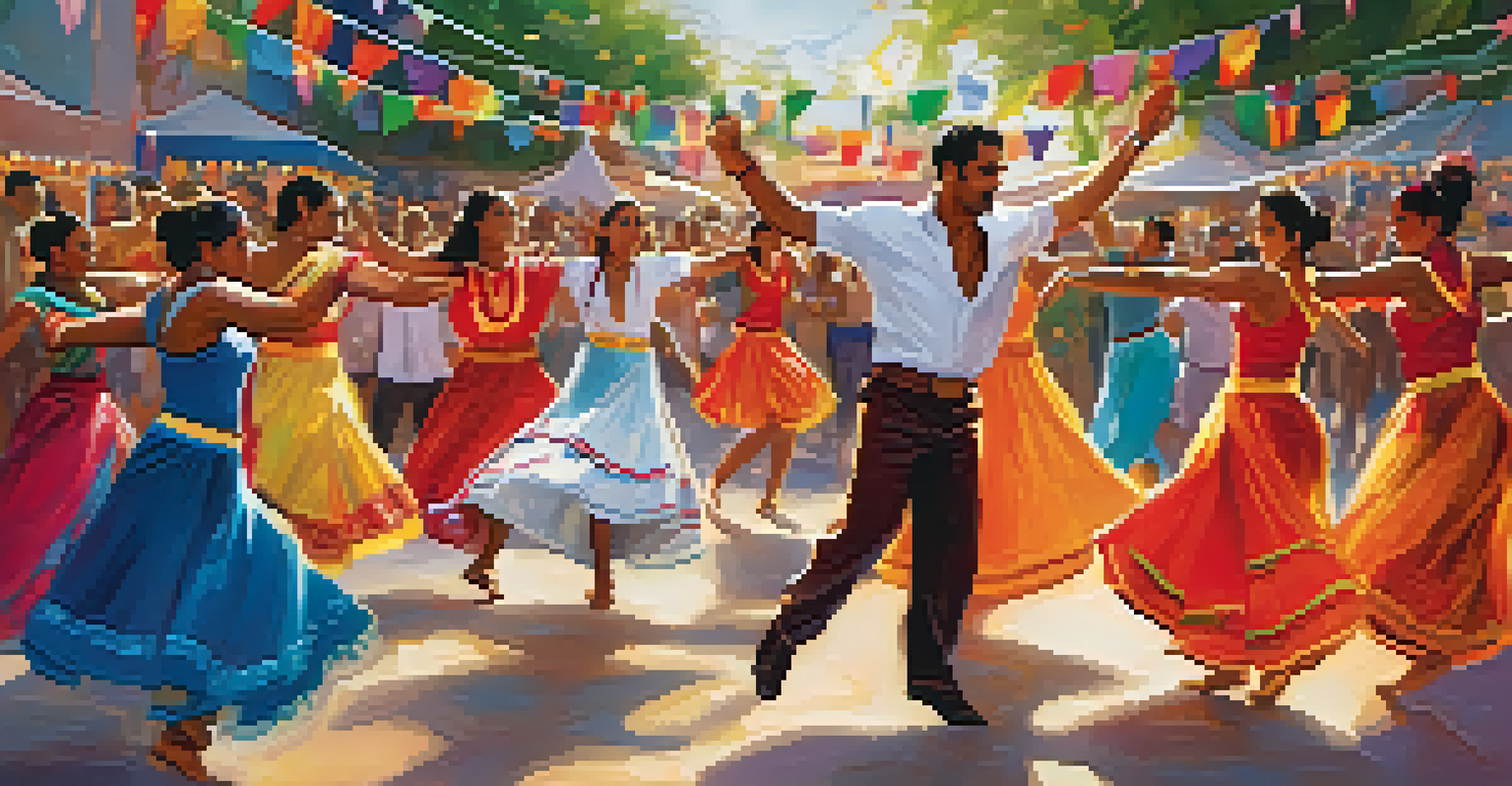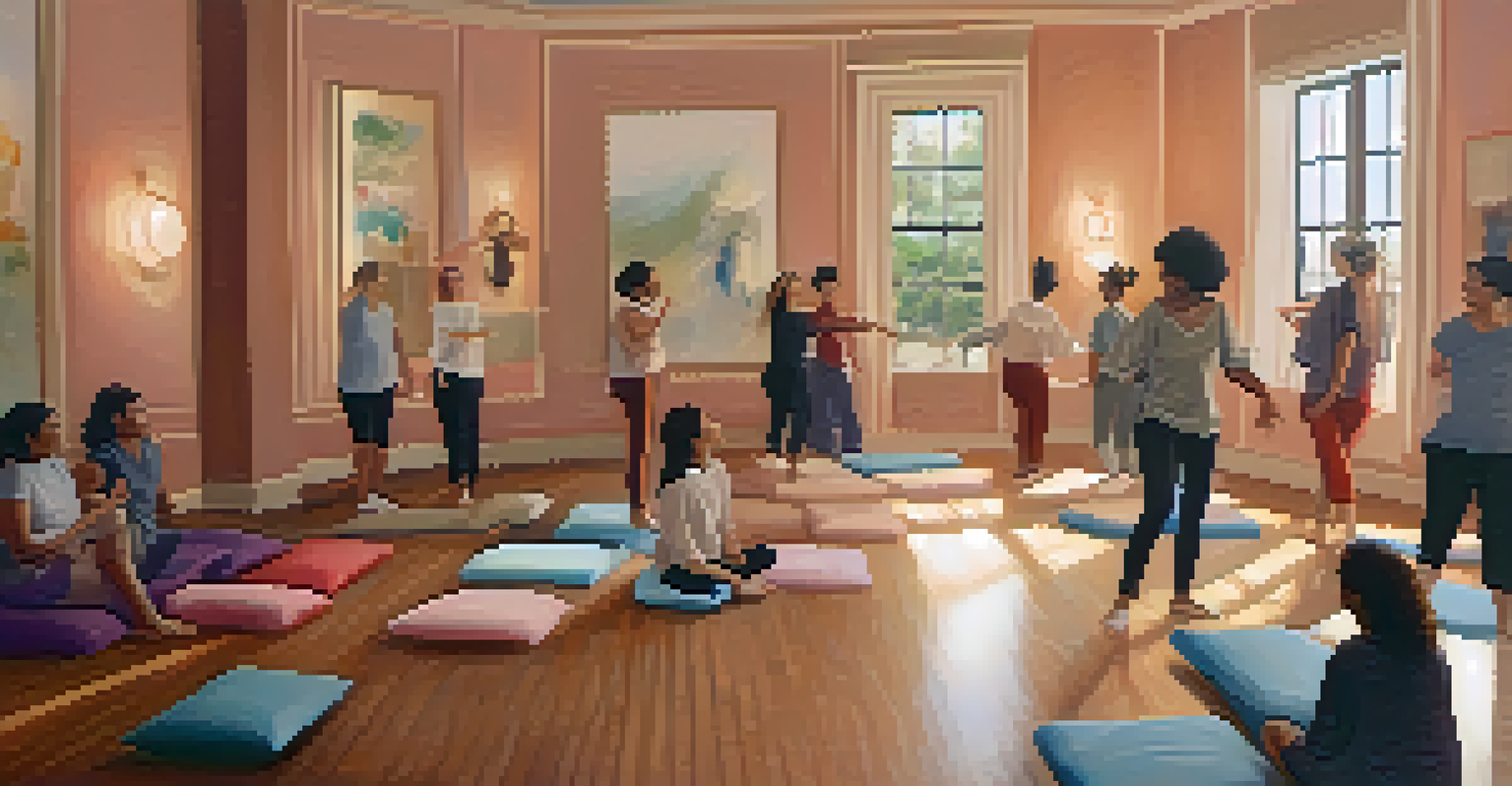The Psychology of Dance: Non-Verbal Communication Insights

Understanding Non-Verbal Communication in Dance
Dance is a unique form of expression that transcends spoken language. Through movement, dancers convey emotions, stories, and ideas without uttering a single word. This non-verbal communication taps into our instincts, allowing us to connect on a deeper level.
Dance is the hidden language of the soul.
Consider how a simple pirouette can express joy, while a slow, fluid movement might evoke sadness. Each gesture carries meaning, often influenced by cultural contexts and personal experiences. In this way, dance becomes a universal language, bridging gaps between different backgrounds.
Moreover, the psychology of dance reveals how our body language can affect our own emotions. Engaging in dance not only communicates feelings to others but also allows dancers to experience catharsis and enhance their own emotional well-being.
The Role of Body Language in Dance Communication
Body language is crucial in dance, as it communicates intentions and emotions that words often cannot convey. The way a dancer holds their posture, the fluidity of their movements, and even facial expressions work together to create a narrative. This intricate dance of body language captivates audiences and fosters connections.

For instance, a confident stance can convey empowerment, while slumped shoulders may suggest vulnerability. Dancers often learn to manipulate their body language to evoke specific reactions from their audience or partners, which can transform a performance into a deeply affecting experience.
Dance as a Universal Language
Through movement, dance transcends verbal communication, allowing individuals to express emotions and stories that resonate across cultures.
Furthermore, understanding body language in dance enhances not only the performance but also the audience's interpretation. This interaction reinforces the non-verbal communication aspect, as viewers respond instinctively to the emotions being portrayed.
Cultural Contexts and Emotional Expressions in Dance
Different cultures have their own unique dance styles, each with distinct ways of expressing emotions. For example, the exuberance of a salsa dance reflects the vibrancy of Latin culture, while the grace of ballet might express elegance and discipline. These cultural nuances play a significant role in how emotions are communicated through dance.
The body says what words cannot.
When dancers perform traditional dances, they not only showcase their physical skills but also honor their heritage and the emotions tied to that culture. This connection deepens the audience's appreciation and understanding of the performance, as they witness the emotional weight carried through generations.
Moreover, cultural influences can shape the way dancers interpret and express emotions. A dancer trained in multiple styles may blend these influences, creating a rich tapestry of non-verbal communication that resonates on various levels with diverse audiences.
The Psychological Benefits of Dance as Expression
Engaging in dance offers numerous psychological benefits, serving as a powerful outlet for emotional expression. Many dancers report feeling a sense of release or relief after performing, as dance allows them to articulate feelings that may be difficult to express verbally. This emotional catharsis is essential for mental health.
In fact, dance therapy is a recognized form of therapy that utilizes movement to help individuals process emotions and trauma. Through guided dance, participants can explore their feelings in a safe space, enhancing self-awareness and fostering personal growth.
Body Language Enhances Dance
The nuances of body language in dance, including posture and facial expressions, play a crucial role in conveying intentions and emotions.
Dance can also boost self-esteem and confidence, as mastering movements and performing can empower individuals. This newfound confidence often translates into other areas of life, creating a positive feedback loop that encourages further self-expression.
The Connection Between Music and Dance in Communication
Music plays a vital role in dance, serving as the backbone that guides movements and emotions. The rhythm and tempo of a piece can influence a dancer's expression, allowing them to synchronize their movements with the beat. This connection deepens the non-verbal communication, as the music enhances the overall experience.
For instance, a lively, upbeat song may inspire energetic, playful movements, while a slow, melancholic tune encourages more introspective expressions. Dancers often interpret music instinctively, translating its emotional nuances into their performances.
Furthermore, this interplay between music and dance demonstrates how non-verbal communication can be multi-faceted. The combination of sound and movement creates a richer narrative, allowing audiences to experience a broader range of emotions.
Dance as a Tool for Social Connection and Bonding
Dance often serves as a social activity, bringing people together in shared experiences. Whether it's a wedding, a club, or a cultural festival, dancing fosters connections among individuals and encourages community bonding. This social aspect enhances the power of non-verbal communication, as people express joy and celebration together.
Consider how a group dance can create a sense of unity; everyone is moving in harmony, sharing a collective emotional experience. This synchronization strengthens social ties, as participants feel connected through the shared act of expression.
Psychological Benefits of Dance
Engaging in dance provides emotional catharsis and boosts self-esteem, serving as a powerful outlet for expression and mental well-being.
In this way, dance transcends individual expression and becomes a medium for collective emotions, reinforcing the importance of non-verbal communication in building relationships and communities.
The Future of Dance and Its Role in Non-Verbal Communication
As society evolves, so does the art of dance, continuously adapting to new forms of expression. With advancements in technology, we are seeing innovative ways to incorporate digital elements into dance, expanding the boundaries of non-verbal communication. Virtual performances and online dance classes are becoming increasingly popular, allowing for new interactions.
These developments may enhance the way we experience dance, making it more accessible to a global audience. As dancers share their art through digital platforms, they continue to convey emotions across distances, showcasing the universal language of movement.

Looking ahead, the role of dance as a tool for non-verbal communication will likely grow even more significant. As we navigate a world that often relies on digital communication, the power of dance to express complex emotions will remain an essential part of our human experience.